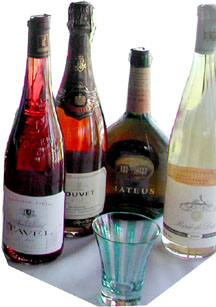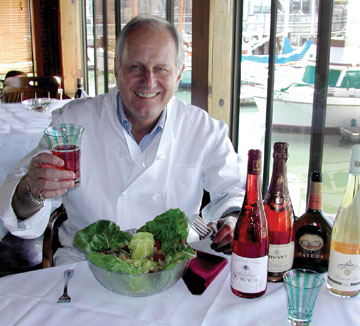Real
Men Can Drink Rose!!!
 By
Bodo Eichler
By
Bodo Eichler
As Fall approaches, along withthe
Bay Area’s warmest time of the year, a Mediterranean outdoor
lifestyle flourishes as does the California penchant for light and
refreshing food and drink. For those fond of wine, it is the prime
time to enjoy the pleasures of quality Roses. Long disdained by wine
snobs as not having any pedigree, and not yet discovered by the
folks happily drinking millions of cases of White Zinfandel, Rose
wines have been part of the Mediterranean lifestyle in Europe for
centuries.
In this country, wine drinking was
first enjoyed by European immigrants and those fun-loving priests,
with their sacramental wines. Exempt from Prohibition regulations,
the clergy helped maintain a core of production for the California
wine industry.
After Prohibition, wine drinking
by the broad population began to flourish with the introduction of
light-flavored beverages marketed to wean the populace away from the
ever-addictive Coca-Cola. A British quaff called "Cold
Duck" and its many lesser imitators, blazed a trail for
entry-level wines. This was ideal for drinkers who liked their
beverages cold, fruity and of a color pleasing to the eye. At the
same time, inexpensive Rose wines from Portugal, Mateus and Lancer
in attractive odd shaped bottles, became a rage of the mid ‘60s
through the ‘70s along with those straw covered Chianti bottles.
Introduction of the uniquely
Californian "White Zinfandel" by Sutter Home further
refined this approach, giving it broad appeal and, most importantly,
introduced large numbers of people to the pleasures of drinking
wine. White Zin soon became somewhat stereotyped as a favorite wine
for women while men felt compelled to stick to traditional liquor
and began giving microbrewed beers manly names like Arrogant
Bastard or Red Dog.
So, what is Rose and how is it
different from White Zin? The pale White Zin is made from the
California Zinfandel grape in the style of a white wine. Red
Zinfandel grapes are pressed producing a "free run juice"
that has only light coloration from a brief contact with the grape’s
skin. This process produces a light and fresh-tasting wine.
Roses are made from a number of
red wine varietal grapes. In creating Rose, the grapes are allowed
to soak with the skins for one to two days. Then they are crushed
and the juice drawn off or pressed, then fermented without the
skins. This allows the winemaker to give his wine more complexity by
bringing out the very best aspects of the grape variety chosen for
his Rose. It is for that reason that we have a wide range of Rose
styles to choose from. They range from the pleasantly delicate
Mateus, to a full-bodied flavor like Tavel.
So, what is an aspiring Rose
aficionado to do? Our tradition-bound European friends just happily
drink the choice of the winemakers of their region or province. We
Americans, on the other hand, are duty- bound by our constitutional
quest to the pursuit of happiness to have and make choices. To find
a place to start, this will help.
Bodo’s Guide to the Pleasures of
Rose
As a general rule, Roses are to be
enjoyed while still young. Some of the more complex Roses age
gracefully, but after four years are best given as gifts to people
you don’t plan to see again.
Consistent Quality Top Picks
Mateus Rose , Portugal
Very pleasant, popular with the
mature and the very young members of your family for their own
reasons. Attractive bottle makes a handy dispenser for your extra
virgin olive oil.
Dry Rose, Rioja, Spain. Marques de
Caceres
Full fruit with citrus and floral
aromas. Even the self-anointed high priests of winedom at the Wine
Spectator deemed this worthy.
Worthy of trial
Rose of Pinot Noir, Rose de Diel,
Germany Spaetburgunder Weissherbst
Wine with wonderful balance of
fruit and acidity. It can be hard to find and pricey but worth it.
It is my wife’s favorite.
Rose of Grinolio, Heitz Wine
Cellars, St. Helena
Dry with distinct strawberry and
rhubarb notes, one of California’s better offerings.
Tavel Rose, Rhone, France
Rhone-style grapes, traditionally
considered a most full-bodied Rose with the tannins of a light red
wine. A very versatile food wine. To be drunk young. This is my
favorite.
Bandol Rose, Domaine Tempier,
Provence, France
Dry with a complex blend of fruit
flavors. It is lighter than a Tavel. Expensive compared to the
others and not always worth the money. But, even savant friends at
the Berkeley Faculty Club will give this a passing nod, under the
right circumstances, of course.
Sparkling Bouvet Rose, Samur,
France
Last, but certainly not least. A
very pleasant methode champenoise sparkling wine that provides very
good value and pleasant drinking.
These wines are a good
introduction, or starting point, to be able to identify the major
styles of Rose. There remains a vast selection of Rose wine from
many countries and California counties to explore. My approach is
experimentation. Finding a Rose we enjoy, we buy a case. Rose
supplies are as yet limited, due to light demand. Style and quality
can vary between vintages. Both are real reasons to try, then buy.
Rose is a most pleasant accompaniment to any picnic, cheese and
fruit, appetizers, salads, pork, salmon or any rich seafood, or
chicken when accompanied with a sweet or savory sauce. Rose is
simply enjoyable as a pleasant cocktail.
How To Drink Rose
 Forget
the fancy wine glass!!!! Roses are best enjoyed in a sturdy
highball-style glass that fits in a boat’s cup holder. Keep the
bottle chilled and the glass half full. Not a bad way to go through
life. Cheers!
Forget
the fancy wine glass!!!! Roses are best enjoyed in a sturdy
highball-style glass that fits in a boat’s cup holder. Keep the
bottle chilled and the glass half full. Not a bad way to go through
life. Cheers!
Bodo is the delightful owner of
Quinn’s Lighthouse Restaurant in Embarcadero Cove, Oakland since
1986. A lover of fine wine and good beer, he maintains an extensive
selection of both. As a people person, Bodo was attracted to the
hospitality industry at an early age. Born into a military family in
Strasburg at the close of WWII, his family stayed in Europe through
most of his youth. At 15, he had the good fortune to be able to
enter a European apprentice program for both cooking and restaurant
management in Heidelberg, Germany and Lausann, Switzerland. Bodo
moved from Canada to the United States in 1980, becoming a U.S
citizen in 1988. He loves to cook at home for his appreciative wife
Mary, where new recipes are often developed and enjoyably tested.
Bodo has a Ph.D. in life experience and a solid grounding in
European-style techniques mixed with southern flare, which he pairs
with fresh California fare to share with his patrons.